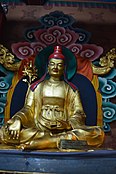| Part of a series on |
| Mahāyāna Buddhism |
|---|
 |
Mādhyamaka ("middle way" or "centrism"; Chinese: 中觀見; pinyin: Zhōngguān Jìan; Tibetan: དབུ་མ་པ་ ; dbu ma pa), otherwise known as Śūnyavāda ("the emptiness doctrine") and Niḥsvabhāvavāda ("the no svabhāva doctrine"), refers to a tradition of Buddhist philosophy and practice founded by the Indian Buddhist monk and philosopher Nāgārjuna (c. 150 – c. 250 CE).[1][2][3] The foundational text of the Mādhyamaka tradition is Nāgārjuna's Mūlamadhyamakakārikā ("Root Verses on the Middle Way"). More broadly, Mādhyamaka also refers to the ultimate nature of phenomena as well as the non-conceptual realization of ultimate reality that is experienced in meditation.[4]
Since the 4th century CE onwards, Mādhyamaka philosophy had a major influence on the subsequent development of the Mahāyāna Buddhist tradition,[5] especially following the spread of Buddhism throughout Asia.[5][6] It is the dominant interpretation of Buddhist philosophy in Tibetan Buddhism and has also been influential in East Asian Buddhist thought.[5][7]
According to the classical Indian Mādhyamika thinkers, all phenomena (dharmas) are empty (śūnya) of "nature",[8] of any "substance" or "essence" (svabhāva) which could give them "solid and independent existence", because they are dependently co-arisen.[9] But this "emptiness" itself is also "empty": it does not have an existence on its own, nor does it refer to a transcendental reality beyond or above phenomenal reality.[10][11][12]
- ^ Williams 2000, p. 140.
- ^ Thakchoe, Sonam (Summer 2022). "The Theory of Two Truths in Tibet". In Zalta, Edward N. (ed.). Stanford Encyclopedia of Philosophy. The Metaphysics Research Lab, Center for the Study of Language and Information, Stanford University. ISSN 1095-5054. OCLC 643092515. Archived from the original on 28 May 2022. Retrieved 5 July 2022.
- ^ Wynne, Alexander (2015) Early Buddhist Teaching as Proto-śūnyavāda. Journal of the Oxford Centre for Buddhist Studies, 6. pp. 213-241.
- ^ Brunnholzl 2004, p. 29-30.
- ^ a b c Donnelly, Paul B. (25 January 2017). "Madhyamaka". Oxford Research Encyclopedia of Religion. Oxford: Oxford University Press. doi:10.1093/acrefore/9780199340378.013.191. ISBN 9780199340378.
- ^ Acri, Andrea (20 December 2018). "Maritime Buddhism". Oxford Research Encyclopedia of Religion. Oxford: Oxford University Press. doi:10.1093/acrefore/9780199340378.013.638. ISBN 9780199340378. Archived from the original on 19 February 2019. Retrieved 30 May 2021.
- ^ Hugon, Pascale (Spring 2020). "Tibetan Epistemology and Philosophy of Language". In Zalta, Edward N. (ed.). Stanford Encyclopedia of Philosophy. The Metaphysics Research Lab, Center for the Study of Language and Information, Stanford University. ISSN 1095-5054. OCLC 643092515. Archived from the original on 20 June 2022. Retrieved 5 July 2022.
- ^ Brunnholzl 2004, p. 70.
- ^ Brunnholzl 2004, p. 590.
- ^ Cheng 1981.
- ^ Garfield 1994.
- ^ Garfield 2012.



